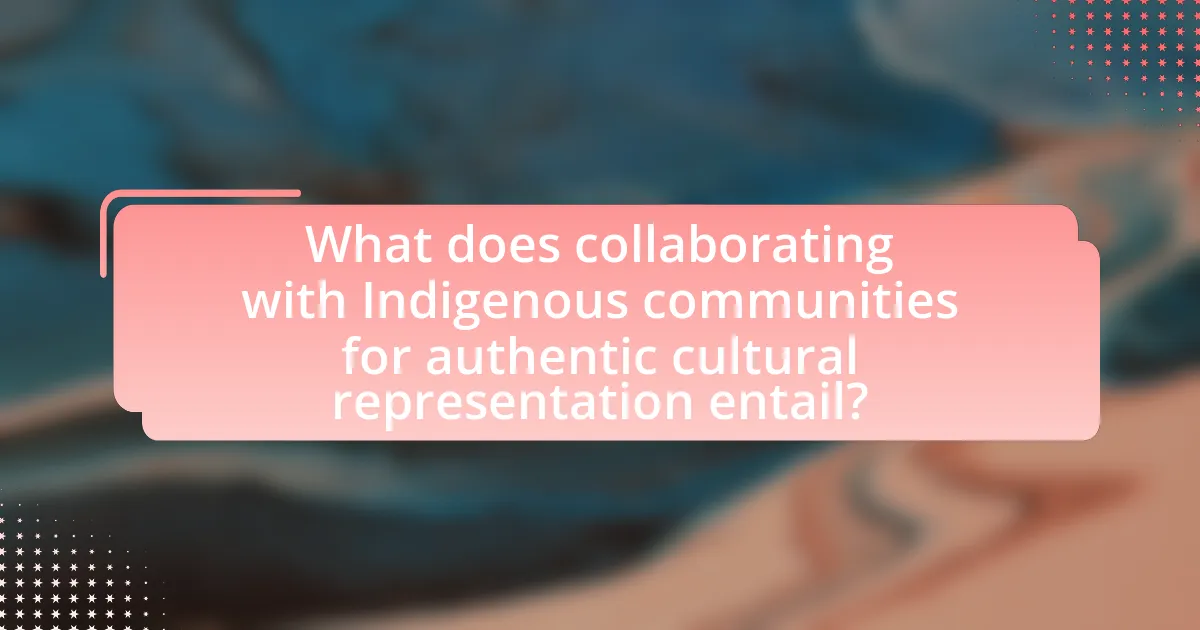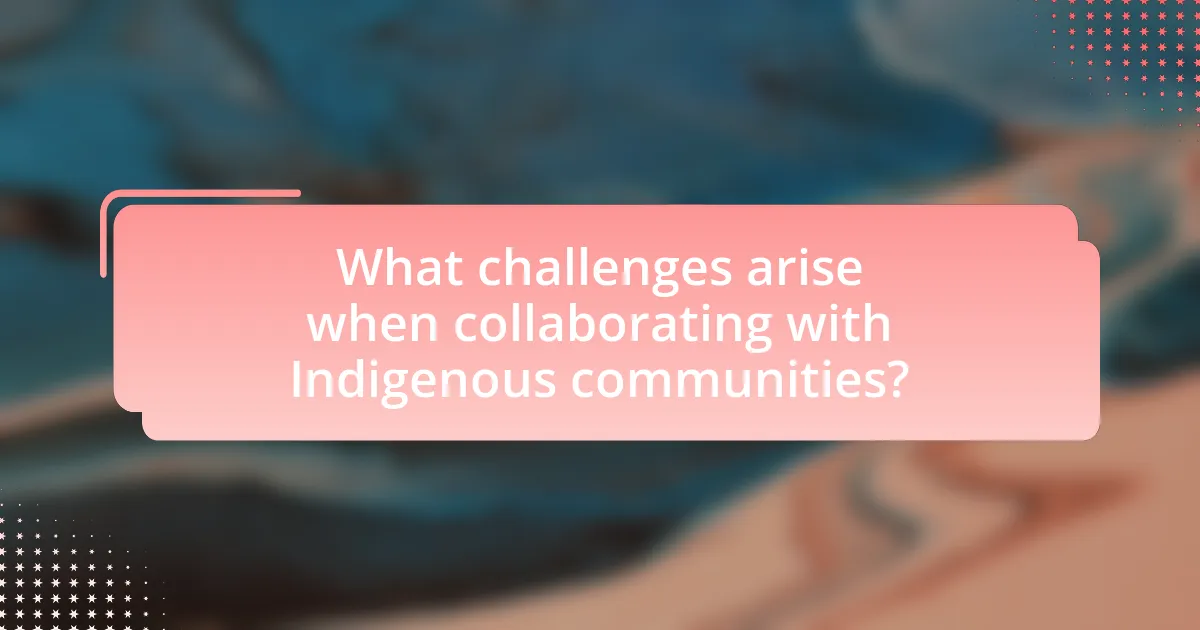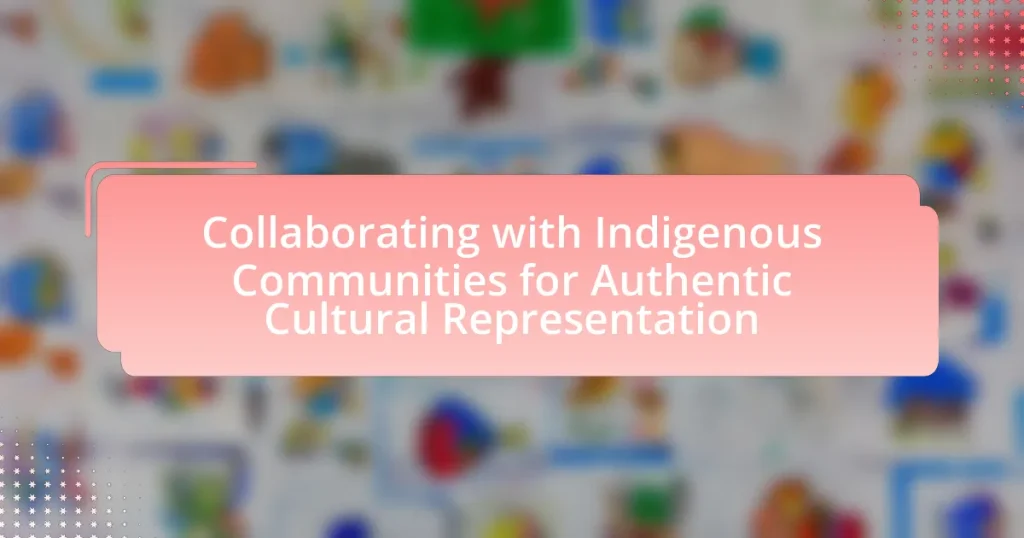Collaborating with Indigenous communities for authentic cultural representation involves direct engagement to accurately reflect their voices, traditions, and perspectives in cultural projects. This collaboration is grounded in principles such as mutual respect, informed consent, and meaningful engagement, emphasizing the importance of Indigenous participation in decisions affecting their cultural heritage. Historical contexts, including colonialism and cultural appropriation, highlight the necessity for such partnerships to restore agency and representation. Effective collaboration enhances the authenticity of cultural narratives, addresses power dynamics, and challenges misconceptions, ultimately fostering a deeper understanding and appreciation of Indigenous cultures.

What does collaborating with Indigenous communities for authentic cultural representation entail?
Collaborating with Indigenous communities for authentic cultural representation entails engaging directly with these communities to ensure their voices, traditions, and perspectives are accurately reflected in cultural projects. This collaboration involves establishing trust, respecting Indigenous knowledge systems, and prioritizing community input throughout the creative process. For instance, the United Nations Declaration on the Rights of Indigenous Peoples emphasizes the importance of obtaining free, prior, and informed consent from Indigenous peoples before undertaking projects that affect their cultural heritage. Such collaboration not only fosters genuine representation but also helps to preserve and promote Indigenous cultures in a way that honors their significance and integrity.
Why is collaboration with Indigenous communities important for cultural representation?
Collaboration with Indigenous communities is crucial for cultural representation because it ensures that their voices, perspectives, and traditions are authentically included in cultural narratives. This collaboration fosters mutual respect and understanding, allowing for the accurate portrayal of Indigenous cultures, which have often been misrepresented or overlooked in mainstream discourse. For instance, the United Nations Declaration on the Rights of Indigenous Peoples emphasizes the importance of Indigenous participation in decisions affecting their cultural heritage, reinforcing the need for their involvement in cultural representation efforts.
What historical contexts influence the need for collaboration?
The historical contexts that influence the need for collaboration with Indigenous communities include colonialism, cultural appropriation, and the ongoing struggle for Indigenous rights. Colonialism has historically marginalized Indigenous voices and cultures, necessitating collaboration to restore agency and representation. Cultural appropriation has often led to misrepresentation and exploitation of Indigenous cultures, highlighting the importance of authentic partnerships to ensure respectful and accurate cultural representation. Additionally, the ongoing fight for Indigenous rights, including land sovereignty and self-determination, underscores the need for collaborative efforts that empower Indigenous communities and acknowledge their historical grievances. These contexts illustrate that collaboration is essential for fostering mutual respect and understanding in cultural representation.
How does collaboration impact the authenticity of cultural representation?
Collaboration enhances the authenticity of cultural representation by integrating diverse perspectives and knowledge systems. When Indigenous communities collaborate with external entities, they can ensure that their cultural narratives, practices, and values are accurately portrayed, reflecting their true essence. For instance, the partnership between Indigenous artists and non-Indigenous organizations often leads to projects that respect and honor traditional knowledge, as seen in initiatives like the “Indigenous Design and Planning Institute,” which emphasizes community involvement in cultural projects. This collaborative approach not only validates Indigenous voices but also fosters a deeper understanding among broader audiences, thereby enriching cultural representation.
What are the key principles of effective collaboration with Indigenous communities?
The key principles of effective collaboration with Indigenous communities include respect, mutual benefit, and meaningful engagement. Respect involves acknowledging Indigenous rights, cultures, and knowledge systems, which fosters trust and open communication. Mutual benefit ensures that both Indigenous communities and collaborating entities gain value from the partnership, promoting sustainability and shared goals. Meaningful engagement requires active participation of Indigenous voices in decision-making processes, ensuring that their perspectives shape outcomes. These principles are supported by frameworks such as the United Nations Declaration on the Rights of Indigenous Peoples, which emphasizes the importance of free, prior, and informed consent in collaborations.
How can mutual respect and understanding be established?
Mutual respect and understanding can be established through open communication and active listening. Engaging in dialogue that values each party’s perspectives fosters an environment where individuals feel heard and appreciated. Research indicates that when diverse groups participate in collaborative efforts, such as those involving Indigenous communities, the likelihood of achieving mutual respect increases significantly. For instance, a study by the National Congress of American Indians highlights that incorporating Indigenous knowledge and practices into decision-making processes leads to stronger relationships and deeper understanding between communities. This approach not only acknowledges cultural differences but also promotes shared goals, reinforcing the foundation of mutual respect and understanding.
What role does consent play in the collaboration process?
Consent is fundamental in the collaboration process, particularly when working with Indigenous communities, as it ensures that all parties respect cultural values and rights. In this context, obtaining informed consent means that Indigenous communities have the autonomy to agree to participate in projects that involve their cultural heritage, ensuring that their voices and perspectives are prioritized. This practice is supported by the United Nations Declaration on the Rights of Indigenous Peoples, which emphasizes the importance of free, prior, and informed consent in any activities affecting their lands, territories, and resources. By adhering to these principles, collaborators can foster trust, promote ethical engagement, and enhance the authenticity of cultural representation.

What challenges arise when collaborating with Indigenous communities?
Collaborating with Indigenous communities presents challenges such as differing worldviews, historical mistrust, and communication barriers. These challenges stem from the unique cultural perspectives and experiences of Indigenous peoples, which often contrast with mainstream approaches. For instance, historical injustices, such as colonization and forced assimilation, have led to a deep-seated mistrust of external entities, complicating partnership efforts. Additionally, communication barriers may arise due to language differences and varying cultural norms regarding dialogue and decision-making processes. These factors necessitate a careful, respectful approach to collaboration that acknowledges and addresses the specific needs and concerns of Indigenous communities.
How can power dynamics affect collaboration efforts?
Power dynamics can significantly affect collaboration efforts by influencing decision-making processes and resource allocation. In collaborations, particularly with Indigenous communities, unequal power dynamics can lead to marginalized voices being overlooked, resulting in a lack of authentic representation. For instance, research by the National Congress of American Indians highlights that when Indigenous communities are not given equitable power in discussions, their cultural perspectives and needs may be inadequately addressed, leading to ineffective partnerships. This imbalance can foster mistrust and hinder the overall success of collaborative initiatives.
What strategies can be employed to address power imbalances?
To address power imbalances in collaborating with Indigenous communities, strategies such as establishing equitable partnerships, ensuring community representation in decision-making, and fostering mutual respect and understanding can be employed. Equitable partnerships involve recognizing the expertise and rights of Indigenous peoples, which can be facilitated through formal agreements that outline roles and responsibilities. Ensuring community representation means including Indigenous voices in all stages of projects, from planning to implementation, thereby validating their perspectives and knowledge. Fostering mutual respect and understanding can be achieved through cultural competency training for non-Indigenous collaborators, which enhances awareness of Indigenous histories and values. These strategies are supported by frameworks like the United Nations Declaration on the Rights of Indigenous Peoples, which emphasizes the importance of Indigenous participation in decisions affecting their lives.
How do differing worldviews impact collaboration outcomes?
Differing worldviews significantly impact collaboration outcomes by influencing communication styles, decision-making processes, and conflict resolution strategies. For instance, Indigenous worldviews often emphasize community and relational dynamics, which can clash with Western individualistic approaches that prioritize personal achievement and linear thinking. This divergence can lead to misunderstandings and hinder effective collaboration if not acknowledged and addressed. Research indicates that successful collaborations with Indigenous communities require a mutual understanding of these differing perspectives, as highlighted in the study “Indigenous Knowledge and Western Science: A Collaborative Approach” by Berkes et al. (2011), which demonstrates that integrating diverse worldviews can enhance project outcomes and foster trust.
What are common misconceptions about Indigenous cultural representation?
Common misconceptions about Indigenous cultural representation include the belief that all Indigenous cultures are homogenous and that they can be accurately represented by non-Indigenous individuals. This oversimplification ignores the vast diversity among Indigenous communities, each with unique languages, traditions, and histories. Additionally, many people assume that Indigenous cultural elements can be appropriated without permission or understanding, which disregards the significance and sacredness of these practices. Misrepresentation often occurs when Indigenous voices are excluded from the narrative, leading to stereotypes and inaccuracies that perpetuate colonial perspectives. These misconceptions can be challenged by engaging directly with Indigenous communities, ensuring their perspectives and knowledge are integral to cultural representation efforts.
How can these misconceptions hinder effective collaboration?
Misconceptions about Indigenous cultures can significantly hinder effective collaboration by fostering stereotypes and misunderstandings. These inaccuracies can lead to a lack of trust between Indigenous communities and external collaborators, as Indigenous peoples may feel misrepresented or marginalized. For instance, assuming a monolithic Indigenous identity ignores the diversity among different tribes and cultures, which can result in inappropriate or ineffective engagement strategies. Research indicates that when collaborators fail to recognize the unique cultural practices and governance structures of Indigenous groups, projects often face resistance or outright rejection, as seen in various case studies involving land management and cultural heritage initiatives. Thus, addressing these misconceptions is crucial for building respectful and productive partnerships.
What steps can be taken to educate stakeholders about Indigenous cultures?
To educate stakeholders about Indigenous cultures, organizations can implement comprehensive training programs that include workshops led by Indigenous community members. These workshops should cover historical context, cultural practices, and contemporary issues faced by Indigenous peoples. Research indicates that experiential learning, such as cultural immersion experiences, significantly enhances understanding and appreciation of Indigenous cultures. For instance, a study by the National Congress of American Indians found that direct engagement with Indigenous communities fosters respect and reduces stereotypes. Additionally, providing educational materials, such as books and documentaries created by Indigenous authors and filmmakers, can further enrich stakeholders’ knowledge and promote authentic representation.

What best practices should be followed for successful collaboration?
Successful collaboration with Indigenous communities requires mutual respect, open communication, and active participation. Establishing trust is essential, as it fosters a safe environment for sharing ideas and concerns. Engaging community members from the outset ensures that their perspectives and knowledge are integrated into the collaboration process. Additionally, recognizing and valuing Indigenous cultural practices and protocols enhances the authenticity of the partnership. Research indicates that collaborations that prioritize these practices lead to more meaningful and effective outcomes, as seen in projects that have successfully incorporated Indigenous knowledge systems into environmental management.
How can ongoing communication be maintained throughout the collaboration process?
Ongoing communication can be maintained throughout the collaboration process by establishing regular check-ins and utilizing multiple communication channels. Regular check-ins, such as weekly meetings or bi-weekly updates, ensure that all parties are aligned on goals and progress. Utilizing various communication channels, including emails, messaging apps, and video calls, accommodates different preferences and enhances accessibility. Research indicates that consistent communication fosters trust and transparency, which are crucial for effective collaboration, particularly in culturally sensitive contexts like working with Indigenous communities.
What tools and methods facilitate effective communication?
Effective communication with Indigenous communities is facilitated by tools such as culturally relevant technology, face-to-face meetings, and community engagement platforms. Culturally relevant technology includes applications and software designed to respect and incorporate Indigenous languages and traditions, enhancing understanding and connection. Face-to-face meetings allow for personal interaction, fostering trust and rapport, which are essential for meaningful dialogue. Community engagement platforms, such as social media and dedicated forums, provide spaces for ongoing conversation and feedback, ensuring that voices from Indigenous communities are heard and valued. These methods are supported by research indicating that direct engagement and culturally sensitive approaches lead to more effective communication outcomes in collaborative efforts.
How can feedback be integrated into the collaboration process?
Feedback can be integrated into the collaboration process by establishing structured channels for communication that allow for continuous input from all stakeholders. This can include regular meetings, surveys, and feedback sessions specifically designed to gather insights from Indigenous community members throughout the project. Research indicates that involving Indigenous voices in decision-making enhances cultural representation and fosters trust, as seen in the study “Indigenous Participation in Research: A Review of the Literature” by Smith et al. (2019), which highlights the importance of feedback loops in collaborative efforts. By actively seeking and incorporating feedback, the collaboration process becomes more inclusive and responsive to the needs and perspectives of Indigenous communities.
What role do Indigenous voices play in cultural representation?
Indigenous voices play a crucial role in cultural representation by ensuring that their perspectives, traditions, and narratives are authentically portrayed. This representation is vital for preserving cultural heritage and challenging stereotypes that often misrepresent Indigenous peoples. For instance, the inclusion of Indigenous voices in media and arts has led to more accurate depictions of their histories and contemporary issues, as seen in projects like the “Indigenous Screen Office” in Canada, which supports Indigenous filmmakers and storytellers. Such initiatives validate Indigenous experiences and promote a deeper understanding of their cultures among broader audiences.
How can Indigenous perspectives be prioritized in collaborative projects?
Indigenous perspectives can be prioritized in collaborative projects by actively involving Indigenous communities in the decision-making process from the outset. This approach ensures that their knowledge, values, and cultural practices are integrated into the project framework. For instance, the United Nations Declaration on the Rights of Indigenous Peoples emphasizes the importance of free, prior, and informed consent, which mandates that Indigenous peoples must be consulted and their consent obtained before any project affecting their lands or resources is initiated. Additionally, establishing partnerships with Indigenous leaders and organizations can facilitate the incorporation of traditional ecological knowledge, which has been shown to enhance project outcomes and sustainability.
What are the benefits of including Indigenous narratives in cultural representation?
Including Indigenous narratives in cultural representation enhances authenticity, fosters understanding, and promotes social justice. Authenticity is achieved as Indigenous narratives provide genuine insights into cultural practices, beliefs, and histories, which are often misrepresented or overlooked in mainstream narratives. For instance, the inclusion of Indigenous perspectives in media and literature can challenge stereotypes and provide a more nuanced understanding of Indigenous identities. Furthermore, incorporating these narratives fosters mutual respect and understanding between Indigenous and non-Indigenous communities, as it encourages dialogue and collaboration. This approach also supports social justice by recognizing and validating Indigenous voices, which have historically been marginalized. Research indicates that representation of Indigenous narratives can lead to increased awareness and appreciation of Indigenous cultures, ultimately contributing to reconciliation efforts.
What practical steps can organizations take to collaborate authentically with Indigenous communities?
Organizations can collaborate authentically with Indigenous communities by establishing respectful partnerships that prioritize Indigenous voices and knowledge. This involves actively engaging with community leaders to understand their needs and perspectives, ensuring that collaboration is based on mutual respect and trust.
Organizations should also commit to long-term relationships rather than one-off projects, which fosters deeper understanding and shared goals. Providing resources for capacity building within Indigenous communities can empower them to lead initiatives that reflect their cultural values.
Additionally, organizations must incorporate Indigenous knowledge systems into their practices, recognizing the importance of traditional ecological knowledge in areas such as environmental management. Transparency in decision-making processes and sharing benefits equitably with Indigenous communities further solidifies authentic collaboration.
Research indicates that organizations that engage in these practices not only enhance their cultural competence but also contribute to the sustainability and resilience of Indigenous communities, as seen in successful partnerships documented in studies by the United Nations and various Indigenous-led organizations.


